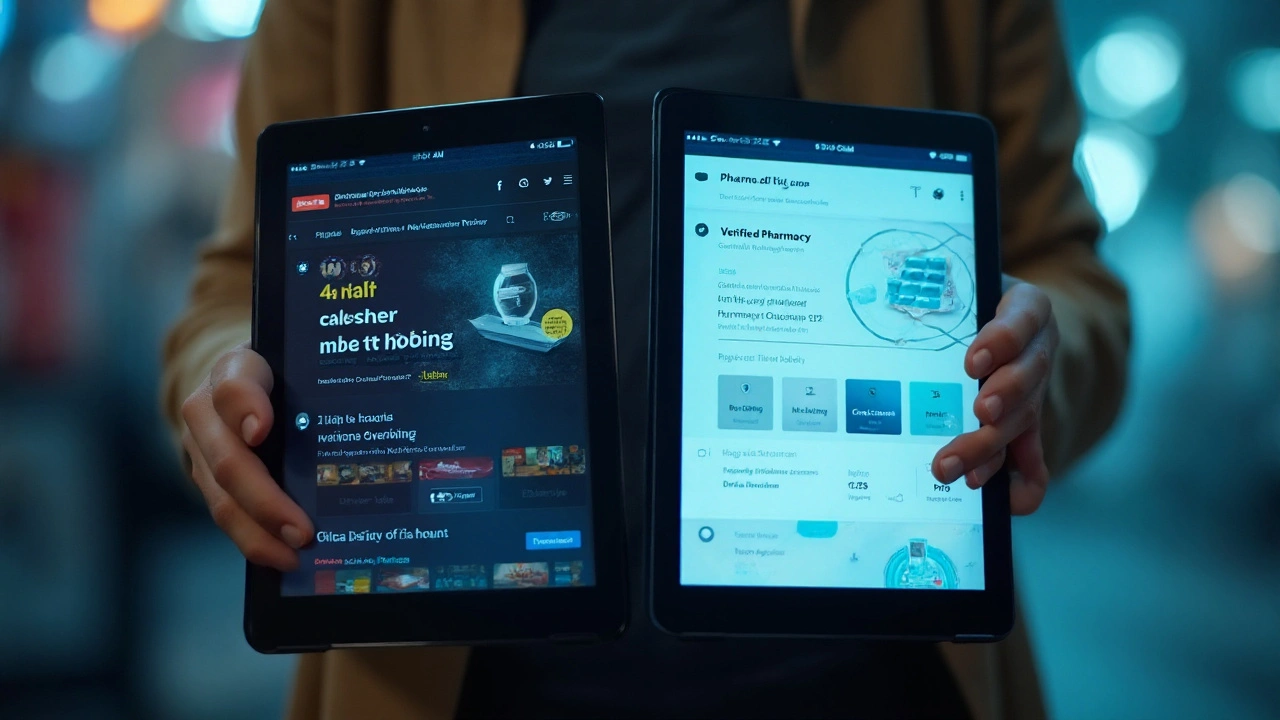You want the lowest price on generic Provera without sketchy websites or surprise fees. Here’s the straight talk: medroxyprogesterone acetate (the generic for Provera) is prescription‑only in New Zealand, so any site offering it without a prescription is a risk to your health and your wallet. You can still keep costs low-legally-by using a registered NZ online pharmacy, choosing the generic, and knowing a few smart tricks that most people miss. I’m writing this from Wellington in September 2025, so the details reflect how things work here right now.
What you’re actually buying-and the safe way to get it online in NZ
Quick clarity before you pull out your card. “Generic Provera” means medroxyprogesterone acetate tablets. That’s different from Depo‑Provera, which is the injectable contraceptive (depot medroxyprogesterone). Same family, totally different use and dosing. If you want contraception, you’re probably thinking of the injection. If your doctor is treating abnormal uterine bleeding, amenorrhoea, endometriosis symptoms, or using it as the progestogen part of HRT, they usually mean tablets.
Uses in plain language:
- Abnormal uterine bleeding not due to something like fibroids or cancer (your doctor rules this out first).
- Amenorrhoea (missing periods) to trigger a withdrawal bleed.
- Endometriosis symptom control (some regimens use higher doses).
- Part of hormone therapy with oestrogen to protect the uterus.
What it’s not: a stand‑alone contraceptive in tablet form. If contraception is your goal, talk to your clinician about options-Depo‑Provera injection, progestogen‑only pills, combined pills, or an IUD.
Legal status (NZ): Prescription‑only. That’s not a barrier-it just means the cheapest, safest online route still goes through a NZ‑registered prescriber and a registered pharmacy.
Step‑by‑step to buy generic Provera online safely in NZ:
- Confirm the medicine and dose with a clinician. If you don’t have a current prescription, book a telehealth consult with a NZ‑registered GP or a women’s health clinic. Ask for the generic name (medroxyprogesterone acetate), not the brand, unless your clinician has a specific reason for the brand.
- Pick a registered NZ online pharmacy. Two quick checks: the pharmacy and the responsible pharmacist should appear on the Pharmacy Council of New Zealand’s public register; Medsafe has consumer guidance on buying medicines online. Look for a real NZ address and a phone/email for pharmacist advice.
- Upload or e‑send your prescription. Check the medicine name, strength (often 5 mg or 10 mg), and quantity. If your prescriber sends an e‑script, the pharmacy can usually match it to your order fast.
- Confirm the total price before paying. Add up: medicine price + any prescription service fee + shipping. Make sure GST is included in the displayed price. If you’re picking up, confirm the price is the same in‑store.
- Delivery and tracking. Most NZ pharmacies ship tracked and deliver within 1-3 business days. Rural can take longer. If timing matters (say you’re syncing a withdrawal bleed), order earlier than you think you need.
Pitfalls to avoid:
- Any site saying “no prescription needed” for medroxyprogesterone. That’s a red flag-and often a counterfeiting risk.
- Overseas sites shipping from unknown locations. Customs issues aside, you can’t be sure about quality, storage conditions, or what you’re actually getting.
- “Verified reviews” that all read like marketing. Trust your pharmacist’s questions; be wary if no one asks for your prescription or checks your other meds.
Smart moves people in NZ use to keep it cheap and simple:
- Ask for the generic (medroxyprogesterone acetate). Same active ingredient, usually lower price.
- Ask about a 3‑month supply if clinically appropriate. One courier fee, fewer repeats.
- Combine orders for your household’s prescriptions to save on shipping.
- Tell your pharmacist about all your meds and supplements. It’s not just safety-sometimes they can recommend a cheaper funded option if your dose or regimen allows it.
Reality check on dosing: Typical regimens are published in official data sheets (for example, cyclic courses like 5-10 mg for 5-10 days), but your doctor’s instructions win. Don’t copy someone else’s dose. Medsafe consumer information, the New Zealand Formulary (NZF), and FDA labels all confirm dosing varies by condition and response.
Who should not take it (summary from Medsafe/NZF): if you’re pregnant or suspect pregnancy; have unexplained vaginal bleeding; current or past clotting events (DVT/PE) without a prescriber’s oversight; active liver disease; hormone‑sensitive cancers; or a history of stroke/heart attack where your clinician says the risk is high. If any of these ring a bell, get medical advice before ordering.

Price expectations in NZ (2025) and how to pay less without cutting corners
Let’s unpack the bill you’ll actually pay when you order online in New Zealand. There are three moving parts: the consult/prescription, the medicine, and the shipping/fees.
- Consult/prescription: If you already have a valid NZ prescription, this is $0. If you need a telehealth consult, expect roughly $0-$65 depending on the provider and whether you qualify for low‑cost care.
- Medicine: If the strength/brand is funded, you may pay little or nothing; some pharmacies may still apply a small service fee. If not funded, expect a retail price that varies by strength (e.g., 5 mg vs 10 mg) and quantity. Asking for the generic usually brings the price down.
- Shipping: Commonly $5-$8 tracked nationwide; rural can be a few dollars more. Same‑day courier in big cities costs extra and isn’t universal.
New Zealand dropped the standard $5 prescription co‑payment in 2023 for most items. Some pharmacies still charge service or handling fees. Funding can differ by brand/strength, and listings can change during the year. Your pharmacist can tell you in a minute if your exact item is funded and what you’ll pay today.
Ballpark thinking (not a quote): for a month of generic tablets when not funded, you often see prices in the low tens of dollars. A 3‑month supply tends to be cheaper per tablet. The swing factor is whether your exact strength is on the funded schedule and the pharmacy’s margin. This is why asking for the generic and a longer supply pays off.
Here’s a quick way to sanity‑check a cart before you buy:
- Is the listing clearly “medroxyprogesterone acetate” with a strength that matches your script?
- Does the site show the pharmacist’s name and NZ registration?
- Do you see GST included and the total price including shipping?
- Is there a way to contact a pharmacist to check interactions?
| Cost component | What to look for | Typical NZ range (2025) | How to reduce it |
|---|---|---|---|
| Consult/prescription | Telehealth fee if you need a new Rx | $0-$65 | Use your usual GP; ask if low‑cost options apply |
| Medicine price | Generic medroxyprogesterone tablets | Low tens of dollars if not funded; minimal if funded | Ask for generic; ask about a 3‑month supply |
| Shipping | Tracked courier NZ‑wide | $5-$8 (rural can be higher) | Click & collect or combine orders |
| Service fees | Packaging/dispensing/admin | $0-$10 | Compare pharmacies; ask up front |
| Your time | Delays from missing info | 1-3 working days delivery | Upload a clear Rx; confirm address; order early |
Why not buy from a cheap overseas site? Three reasons:
- Quality risk. You can’t verify manufacturing or storage. Heat and humidity degrade hormones.
- Legal risk. Personal import rules exist, but importing prescription medicines without meeting NZ requirements can see items seized. Medsafe’s guidance is clear: buying from unverified overseas sites is risky.
- Delays and customs. If your cycle timing matters, a 2-3 week delay ruins the plan.
If budget is tight, ask your doctor about clinically suitable alternatives that may be funded at your dose-sometimes a different progestogen or regimen fits your situation and costs less. Also ask your pharmacy if they have any access or community discounts. Many do; you just have to ask.

Safety, side effects, and the alternatives you should compare (incl. Depo‑Provera)
Medroxyprogesterone is widely used and well‑studied, but like any hormone, it has trade‑offs. Here’s the quick risk‑and‑mitigation rundown, pulling from Medsafe data sheets, the New Zealand Formulary, and FDA product labels.
Common effects people notice:
- Breast tenderness, bloating, or mild fluid retention.
- Headache, mood changes, low‑level nausea.
- Acne or skin changes, appetite changes.
- Changes in bleeding pattern (spotting or delayed bleed during/after a course).
Serious but less common-get urgent help if you see these:
- Symptoms of a clot: leg swelling/pain, sudden chest pain, shortness of breath.
- Eye symptoms like sudden vision changes or severe headache.
- Jaundice, dark urine, severe upper‑right abdominal pain (possible liver issue).
- New heavy or unusual bleeding-especially if you’re peri‑menopausal or post‑menopausal. That needs checking before any progestogen course.
Interactions to mention to your pharmacist:
- Enzyme inducers (e.g., some anti‑seizure meds like carbamazepine, phenytoin; rifampicin; St John’s wort). These can lower hormone levels.
- Other hormone therapies. Your prescriber might adjust doses to protect the lining of the uterus if you’re on oestrogen.
Storage and sanity checks when the courier arrives:
- Check the blister pack is sealed, expiry date is future‑dated, and the strength matches your prescription.
- Tablets should look consistent with the pharmacy label description. If you’re unsure, call the pharmacy before taking any.
- Store below the temperature on the label (commonly below 25°C) and away from moisture.
Tablet vs injection vs other options-what fits which job?
| Option | Typical uses | Dosing frequency | Contraception? | Pros | Watch‑outs |
|---|---|---|---|---|---|
| Medroxyprogesterone tablets (generic Provera) | AUB, amenorrhoea, endometriosis symptoms, HRT progestogen | Daily in short courses or cycles; sometimes continuous | No | Flexible dosing; easy to stop; generic options | Daily adherence; can affect mood/bleeding pattern |
| Depo‑Provera (DMPA injection) | Contraception; sometimes used for endometriosis | Every 12-13 weeks | Yes | Very effective; no daily pills | Delay in return to fertility; possible weight/mood changes; bone density in long‑term use |
| Norethisterone tablets | Bleeding control; period delay; some AUB regimens | Short courses | No | Useful for targeted timing of bleeding | Different side‑effect profile; not for everyone |
| Levonorgestrel IUD (e.g., hormonal IUD) | Heavy bleeding control; contraception | Lasts 3-8 years (device‑dependent) | Yes | Very effective; less systemic hormone | Upfront procedure; spotting early on |
| Tranexamic acid | Heavy menstrual bleeding (non‑hormonal) | Only during bleeding days | No | Non‑hormonal option | Not for clot‑prone patients; indication‑specific |
How to choose between them? Start with your goal. If you’re trying to trigger a bleed after amenorrhoea or protect the endometrium in HRT, tablets make sense. If your real goal is contraception with less daily hassle, the injection or an IUD is more on‑target. For heavy bleeding without needing contraception, a hormonal IUD or tranexamic acid can be excellent-talk it through with your prescriber.
Mini‑FAQ (the stuff you’re likely to ask next):
- Can I buy medroxyprogesterone tablets online without a prescription? No. In NZ, it’s prescription‑only. Sites that skip prescriptions are not safe or legal.
- Is the generic as good as Provera? Yes. Same active ingredient and standard bioequivalence rules. This is backed by Medsafe and FDA generics policy.
- Will tablets work as contraception? Not reliably. The tablet form here isn’t used as the progestogen‑only pill for contraception. If you want birth control, say that to your clinician so you get the right option.
- How fast will it arrive? 1-3 business days is common within NZ once the pharmacy has your prescription. Rural can add a day or two.
- What dose should I take? Use the prescription label. Typical regimens exist (e.g., 5-10 mg for 5-10 days), but they depend on your condition. If you’re unsure, ring the pharmacist.
- What if my period doesn’t start after a course? Call your prescriber. They may check for pregnancy, thyroid or prolactin issues, dose, or timing.
- What if I miss a tablet? Take it when you remember unless it’s almost time for the next dose-don’t double. Check the label or ask your pharmacist for your exact regimen.
- Is it safe if I have migraines or a history of clots? That’s a talk with your clinician. Progestogens have different risk profiles than oestrogens, but clot history matters.
Credible sources you can mention to your doctor or pharmacist: Medsafe consumer information and product data sheets (Provera/Depo‑Provera), the New Zealand Formulary (NZF) entries for medroxyprogesterone, BPAC NZ guidance on abnormal uterine bleeding, and the FDA label for medroxyprogesterone acetate tablets. These are the gold‑standard references behind the dosing and safety points above.
What to do next, depending on your situation:
- You already have a prescription: Choose a registered NZ online pharmacy, upload the script, ask for the generic, and check the final price including shipping. Order early.
- You don’t have a prescription: Book a telehealth consult with a NZ‑registered GP. Be clear about your goals (bleeding control, HRT, endometriosis symptoms). Ask if a 3‑month supply is appropriate.
- You’re actually looking for contraception: Ask about Depo‑Provera injection, hormonal IUD, or a progestogen‑only pill. Tablet “Provera” isn’t the right tool for that job.
- Money is tight: Ask if your regimen has a funded generic; request a longer supply; compare pharmacies for service and shipping fees; pick up in person if that’s cheaper.
- Heavy bleeding or severe pain right now: Don’t wait on a courier. If you feel faint, soak pads hourly, or see clots with severe pain, get urgent care.
You can absolutely get medroxyprogesterone tablets at a fair price online in NZ. Do it the legit way-prescription, registered pharmacy, generic if suitable-and you’ll save money without gambling on your health. If you’re unsure at any step, ring the pharmacy and ask for the pharmacist. That one short call often saves both time and cash.



Neeraj Agarwal
September 12, 2025 AT 00:44The article nails the need for a legit NZ pharmacy, but watch out for a misspelled prescripton on some sites – that's a red flag. Always double‑check the pharmacist's registration number on the Pharmacy Council website. If the price looks too good to be true, the product probably is. Also, verify that GST is included in the total before you pay, otherwise you'll be hit with hidden fees later.
Make a note of the pharmacy's physical address and a working contact number.
Rose K. Young
September 16, 2025 AT 19:41Honestly, if you thought you could dodge the prescription requirement you’re living in a fantasy. Those sketchy sites are a plague and they’ll bleed you dry, literally. Save yourself the headache and stick to the proper channels – anything else is just reckless.
Christy Pogue
September 21, 2025 AT 14:37Hey folks, great rundown! 👍 If you’re feeling overwhelmed, just start with a quick telehealth consult – many NZ doctors offer same‑day appointments online. Ask them specifically for the generic name “medroxyprogesterone acetate” and you’ll save a few bucks. Remember, ordering a three‑month supply not only cuts shipping costs but also means fewer trips to the pharmacy. You’ve got this!
Helena Pearson
September 26, 2025 AT 09:34🧠 Think of the prescription as a safety net – it ensures the dosage matches your condition, and the pharmacist can catch any drug interactions. 🌿 The NZ regulatory framework actually protects you from counterfeit hormones, which is a huge win. 🎯 If you ever feel unsure, a quick call to the pharmacy’s on‑call pharmacist can clear up doubts before you click “buy”.
Patricia Fallbeck
October 1, 2025 AT 04:31Oh, you think “any online store will do”? How quaint! The truth is, the market is flooded with bogus sellers promising miracles at half the price. In reality, you’re risking sub‑potent or contaminated tablets – a nightmare for anyone on hormonal therapy. So, dear readers, let’s not romanticize the dark corners of the internet; stick to verified NZ pharmacies and keep your health intact.
Brett Snyder
October 5, 2025 AT 23:27New Zealand has one of the toughest drug safety laws in the Commonwealth – and we should be proud of that. Don’t let foreign knock‑offs tarnish our reputation; use home‑grown services that respect our standards. Supporting local pharmacies also keeps the money circulating within our community.
Nidhi Jaiswal
October 10, 2025 AT 18:24Check the pharmacy licence on the council site. Ensure the prescription is uploaded correctly. Confirm total price includes GST and shipping. Simple steps avoid hidden costs and illegal meds.
Sunil Sharma
October 15, 2025 AT 13:21Friends, think of this as a quick checklist: 1️⃣ Verify the pharmacy’s NZ registration. 2️⃣ Upload a clear e‑script. 3️⃣ Ask for the generic name to lower price. 4️⃣ Review the final invoice for any extra fees. Following these steps keeps the process smooth and saves you time and money.
Leah Robinson
October 20, 2025 AT 08:17Super helpful guide! 🌟 I love that they mention combining orders to cut shipping. It’s a smart hack for families sharing meds. Keep spreading the word! 😊
Abhimanyu Lala
October 25, 2025 AT 03:14Too many sites claim “no prescription”. Not true. Stick to legit NZ pharmacies.
Richard Sucgang
October 29, 2025 AT 21:11While the guide is thorough, it glosses over the fact that telehealth fees can vary wildly – some providers charge up to $65, which can offset any savings on the medication itself. Also, the claim that generic tablets are always cheaper ignores bulk pricing agreements that some pharmacies have with suppliers, making certain brand names competitively priced. Lastly, the piece fails to address the potential delay in courier services during peak holiday seasons, which can disrupt timing for cyclical dosing.
Russell Martin
November 3, 2025 AT 16:07Quick tip: if you have a regular GP, ask them to send an e‑script directly to the chosen pharmacy – this often reduces the administrative fee. Also, many pharmacies offer a “click‑and‑collect” option; picking up the parcel at a local branch can shave $5‑$8 off shipping.
Jenn Zee
November 8, 2025 AT 11:04In contemplating the complexities of acquiring medroxyprogesterone acetate within the jurisdiction of New Zealand, one must first acknowledge the layered regulatory architecture that underpins pharmaceutical distribution, for it is not merely a bureaucratic hurdle but a safeguard designed to protect public health. The Medicine Act of 1981, as amended, explicitly categorises this compound as prescription‑only, thereby mandating that any dispensing entity must obtain a verifiable directive from a qualified medical practitioner. This legal requirement is reinforced by the Pharmacy Council of New Zealand, which maintains a publicly accessible register of all licensed pharmacies and their responsible pharmacists, a resource that should be consulted before any transaction is initiated. Moreover, Medsafe, the national medicines regulator, issues comprehensive guidance on the importation of prescription medicines, cautioning against the procurement of unregistered products from overseas vendors, whose quality control standards may be indeterminate. When a patient elects to engage a telehealth service, it is prudent to verify that the provider is registered with the Medical Council of New Zealand, as unregistered practitioners might issue scripts that lack legal standing, thereby jeopardising the downstream dispensing process. The cost structure associated with acquiring the generic tablets can be dissected into three principal components: the professional fee for the clinical consultation, the wholesale acquisition cost of the active pharmaceutical ingredient, and the logistical expense of courier delivery, each of which can exhibit variability contingent upon geographic location and service provider policies. In rural districts, for instance, the delivery surcharge may rise by several dollars, reflecting the increased logistical burden borne by the carrier. It is also noteworthy that the NZ Pharmaceutical Schedule periodically revises funding allocations, meaning that what is currently unfunded may become subsidised in subsequent budget cycles, an aspect that conscientious patients should monitor. The practice of requesting a three‑month supply, when clinically appropriate, serves to amortise the fixed costs of shipping and dispensing over a longer therapeutic interval, thereby enhancing cost‑effectiveness. Patients should also be vigilant regarding the integrity of the product upon arrival: the blister pack must remain sealed, the expiry date must extend beyond the intended usage period, and the presentation should correspond precisely to the prescription specifications. Any deviation warrants immediate communication with the dispensing pharmacy, as the acceptance of compromised medication can precipitate therapeutic failure or adverse events. Finally, the decision to pursue generic versus brand‑name formulations should be informed by bioequivalence data, which, in the context of hormonal agents, is rigorously evaluated by both Medsafe and international regulatory bodies such as the FDA, ensuring that the therapeutic outcomes remain consistent across formulations. By adhering to these multifaceted considerations, the patient not only safeguards their own health but also upholds the integrity of the national healthcare system.
don hammond
November 13, 2025 AT 06:01Oh sure, just click “buy cheap meds” and hope for the best, right? 😂 In reality, the only thing cheaper than a legit NZ pharmacy is a broken heart from a side‑effect. 🤷♂️
Ben Rudolph
November 18, 2025 AT 00:57Skipping the prescription is just reckless.
Ian Banson
November 22, 2025 AT 19:54The British system would never allow such lax online sales; New Zealand’s approach is far superior in protecting patients.
marcel lux
November 27, 2025 AT 14:51Thanks for the thorough guide – I’ll definitely double‑check the pharmacy’s registration and ask for the generic to keep costs down.
Charlotte Shurley
December 2, 2025 AT 09:47It’s helpful to see the breakdown of costs and the emphasis on using verified NZ pharmacies.
Steph Hooton
December 7, 2025 AT 04:44Dear community, I applaud the clear instructions provided; they empower patients to obtain necessary medication responsibly while minimizing unnecessary expenditure. Please remember to keep a record of your prescription details and to consult your pharmacist should any doubts arise regarding dosage or potential interactions. Your health is paramount, and adhering to these guidelines ensures both safety and cost‑effectiveness. Wishing everyone a smooth and safe experience with their treatment.